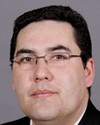Okay.
Again, it is heavily characterized by devolution to first nations management.
The majority of first nations elementary and secondary students, some 60%, attend approximately 500 first-nations-run schools on reserve. So about 60% of first nations students are in schools in their on-reserve communities, and about 38% to 39%--just about 40%--attend schools in the provincial system, as do, of course, a great number of aboriginal people who reside off reserve.
I should mention that the programs the department is funding support the tuition costs for first nations students in on-reserve schools and support the tuition costs for first nations on-reserve students who study in provincial schools. As I said, we no longer play a direct role in education delivery. About 1.4% of students attend seven schools that remain under the direct administration of the department.
First nations and Inuit, or their administering organizations, deliver INAC post-secondary student support, distributing and reporting on funds allocated to eligible students.
On page 6 there is a little more about the specifics and the funding of those programs. There is $1.1 billion annually to support students living on reserve. As you see in the breakdown, the majority of that is for the core elementary-secondary costs. There is $101 million for special education, which involves discerning students' unique learning challenges and correcting them or helping students to rise to them as early in life as possible.
There is $40 million for something called the New Paths for Education initiative. This is a supplementary program that allows first nations to develop success opportunities that meet their particular needs. It could be for more involvement of parents in schools. It could involve particular curriculum development. It could involve introducing better technology, and so on. There is a large array of options for enhancing education capacity.
And there is $8.5 million for the network of 111 cultural education centres across the country.
Post-secondary education programs provide approximately $300 million annually to support 25,000 post-secondary first nations and Inuit learners across Canada.
The Indian and Northern Affairs Canada education branch also administers the first nations and Inuit youth employment strategy, which has a budget of $24 million.
On pages 7, 8, and 9 we describe work that's currently under way under a heading we refer to as a renovated education action plan. The department, in strong consultation and strong partnership with first nations, primarily through the Assembly of First Nations, is working on a new education action plan, the objective of which is to see a revamped education policy framework—you may want to move to page 9, where it's best described—that would redevelop the principles, better define the roles and responsibilities, and clearly define the goals, strategies, and expected outcomes. And we will do this in agreement with first nations and in a way that will give us a policy suite that clearly and best reflects the ambitions and interests of aboriginal people. We work with an AFN/INAC steering committee on this goal.
Accompanying the policy framework will be a comprehensive management framework. The management framework will cover all aspects of managing the resources and program results. So it will cover how to describe objectives, how to measure outcomes, how to report on outcomes, how to eliminate unnecessary reports, how to agree on what reports are important, and how to have an effective management, accountability, and measurement system that works for first nations and that answers the requirements of the first nations and the Government of Canada.
That education action plan, with these major components, is scheduled for completion early in 2007. The work is under way now. There will be milestones all the way through. The department will look forward to reporting to you at committee as major milestones are met.
With respect to on-reserve first nations education, our minister touched on this point when he met with committee last week. He talked about the absence of a legislative framework for first nations education. He described it as something that's essential, that should be pursued on a priority basis.
Since 1995, self-government negotiations have resulted in recognition of first nations jurisdiction over education in various ways. Jurisdiction, the full transfer of responsibility, has been achieved where full self-government has been achieved. Where a fully self-governing first nation like the Nisga'a have come about, education is a component where the first nation has jurisdiction and manages its affairs. In other words, it is removed from the Indian Act.
The Indian Act is very sparse in terms of its legislative help in the area of first nations education. Another example of how this has been responded to is something called the Mi'kmaq education agreement. In Nova Scotia, first nations have come together. The federal government has passed legislation that effectively transfers jurisdiction to the first nations in Nova Scotia that have partnered under this agreement. At the same time, the Province of Nova Scotia passed legislation recognizing the first nations jurisdiction over education. So where there's this traditional constitutional provincial responsibility, notwithstanding that it's not interpreted to apply in the first nations context, they have recognized through legislation...and entered into cooperative arrangements with the first nations in Nova Scotia.
With this jurisdiction, the legal jurisdiction, the first nations in Nova Scotia have come together to create a school-board-type entity in which they, in turn, vest the authority the legislation has given to the individual first nations. They now have a school board system with strong links to the provincial system, and they have full jurisdiction over education.
These are examples of areas that we think are very important to continue to explore to bring legislative certainty to the education rights and privileges of first nations people and aboriginals, and also to better align responsibility with where control really is. As the minister mentioned a few days ago, in the system we have now, the education file has devolved. The control rests with first nations. The minister and the department have relatively little control; yet, technically and legally speaking, the minister remains responsible under the Indian Act.
With respect to aboriginal learners and provincial and territorial education systems, provincial and territorial legislatures have exclusive legislation over education, except on reserve. About four out of five aboriginal learners attend either provincial or territorial educational institutions. As I mentioned earlier in terms of the fall first ministers event, provinces and territories are very much willing to work with the Government of Canada to improve outcomes among all aboriginal learners on and off reserve.
While they have control and manage education in their communities, many first nations leaders have a high number of their residents studying off reserve. They are interested in working increasingly with the provinces, so the provincial education system better serves first nations students studying off reserve.
The provincial system has a great deal to offer first nations in developing the systems components of their education that are now underdeveloped, and first nations are interested in those partnerships. Of course, first nations are interested in pursuing that in a way that does not compromise their jurisdiction, does not compromise their ambition for jurisdiction in what they see, I believe, as an important imperative in having a great deal of say about the educational outcomes of their young people.
In concluding, if today's aboriginal children and youth—more than 315,000 of them—can succeed in education, they will be empowered with choice and self-reliance and they will make a full contribution to the economic prosperity of Canada. Increasingly, with human resource shortages, as the fastest-growing demographic, aboriginal young people will have an increasingly important role to play in the mainstream of economics and the economic prosperity of the country. Governments, aboriginal leaders, learning institutions, and educators are ready to work together in support of fundamental change in aboriginal education.
On that, I thank you. If I have any time left, I will give the floor to my colleague Mr. Caron.





